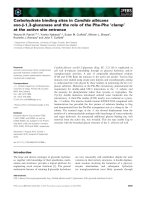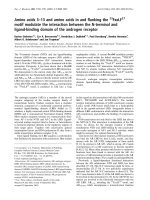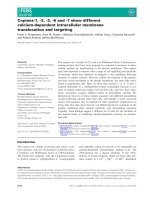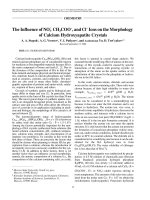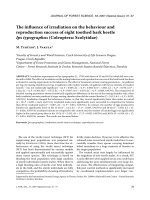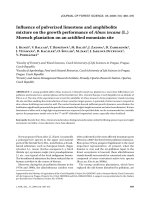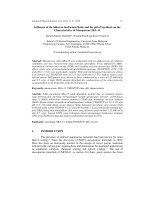The influence of NO 3 −, CH3COO−, and cl− ions and the morphology of calcium hydroxyapatite crystals
Bạn đang xem bản rút gọn của tài liệu. Xem và tải ngay bản đầy đủ của tài liệu tại đây (209.35 KB, 4 trang )
ISSN 0012-5016, Doklady Physical Chemistry, 2007, Vol. 412, Part 1, pp. 11–14. © Pleiades Publishing, Ltd., 2007.
Original Russian Text © A.A. Stepuk, A.G. Veresov, V.I. Putlyaev, Yu.D. Tret’yakov, 2007, published in Doklady Akademii Nauk, 2007, Vol. 412, No. 2, pp. 211–215.
11
Calcium hydroxyapatite Ca
10
(PO
4
)
6
(OH)
2
(HA) and
related calcium phosphates are of considerable interest
for medicine as biocompatible materials because HA is
the main component of bones and teeth [1, 2]. Due to
the closeness of the composition of HA to that of the
bone mineral and unique physical and chemical proper-
ties, materials based on calcium phosphates are widely
used as ceramics, cements, and composites. HA pow-
ders are also used in many other fields: chromato-
graphic separation of proteins and amino acids, cataly-
sis, sorption of heavy metals, and others.
Crystals of synthetic apatite and its biological ana-
logue differ in shape and size [1]. In particular, bone
apatite exists in the form of flat crystals less than 50 nm
long. The most typical shape of synthetic apatite crys-
tals is an elongated hexagonal prism. Inasmuch as the
surface state and area of HA often affect the effective-
ness of a powder in its application (including in medi-
cine and biology), the morphology of HA crystals is of
special interest [2].
The nonstoichiometry range of hydroxyapatite
Ca
10 –
x
(PO
4
)
6 –
x
(HPO
4
)
x
(OH)
2 –
x
(0 <
x
< 10)
is known to
be rather wide (the molar ratio Ca : P = 1.5–1.67).
Among the factors potentially important for the mor-
phology of HA crystals synthesized from solutions (the
initial solution concentration, pH, synthesis tempera-
ture, solution ionic strength, and concentration of an
impurity ion (modifier)), we consider in this work the
first three of them. These are precisely the factors that
should be chosen when planning to obtain HA by pre-
cipitation from a solution, whereas the introduction of
an impurity ion is not a necessary condition for the syn-
thesis [3–6]. In addition to these factors, there is yet
another factor that can influence crystal morphology,
namely, the anionic composition of a solution (i.e., the
composition of the calcium-containing salt); as a rule,
this factor is ignored in crystal shape analysis. We
assumed that the modifying effect of anions on the mor-
phology of HA crystals could be caused by specific
interactions of the anions with growing crystals: (i)
adsorption of the anion on the apatite surface or (ii)
substitution of this anion for the phosphate or hydrox-
ide ion in the HA lattice.
In this work, calcium nitrate, chloride, and acetate
were used as calcium-containing salts. These salts were
chosen because of their high solubility in water (for
example,
= 42.8
20
g/100
g H
2
O,
= 43.6
20
g/100 g H
2
O). The nitrate
anion can be considered to be a nonmodifying ion
because it does not enter the HA structure and is not
subject to hydrolysis. The acetate ion, vice versa, is
involved in ionic equilibria: it hydrolyzes, decreases the
medium acidity, and interacts with a calcium ion to
form an ion associate (ion pair)
CH
3
COOCa
+
(
=
1.18, where
K
is the ion pair formation constant). It is
unclear whether the acetate ion can enter the apatite
structure. It is only known that the acetate ion promotes
the formation of octacalcium phosphate (whose struc-
ture can, under certain conditions, include dicarboxylic
acids) at 40
°
C in a neutral solution. The chloride ion is
considered to be a modifying one because it can be sub-
stituted for the HA hydroxyl ions to form
Ca
10
(PO
4
)
6
(OH,Cl). The water solubility of chlorapa-
tite is less than that of HA [7].
Calcium hydroxyapatite was synthesized by precip-
itation. A 0.5 M solution of chemically pure (Russian
State Standard) potassium hydrogen phosphate
K
2
HPO
4
(60 mL) was slowly (
~2
mL/min) added to
40 mL of a 0.5 M solution of a calcium salt
CaX
2
(X =
CH
3
COO
–
, Cl
–
,
or
N
) under vigorous stirring at
room temperature. The amounts of the salts were calcu-
lated from the molar ratio Ca : P = 1.67 (to obtain the
stoichiometric hydroxyapatite). Potassium hydroxide
S
Ca NO
3
()
2
4H
2
O⋅
S
Ca CH
3
COO()
2
H
2
O⋅
Klog
O
3
–
The Influence of N
,
CH
3
COO
–
, and Cl
–
Ions on the Morphology
of Calcium Hydroxyapatite Crystals
A. A. Stepuk
a
, A. G. Veresov
a
, V. I. Putlyaev
a
, and
Academician
Yu. D. Tret’yakov
a, b
Received September 13, 2006
DOI:
10.1134/S0012501607010046
O
3
–
a
Moscow State University, Vorob’evy gory,
Moscow, 119992 Russia
b
Kurnakov Institute of General and Inorganic Chemistry,
Russian Academy of Sciences, Leninskii pr. 31,
Moscow, 119991 Russia
CHEMISTRY
12
DOKLADY PHYSICAL CHEMISTRY
Vol. 412
Part 1
2007
STEPUK et al.
KOH (chemically pure) was used to maintain the target
pH at 10:
(1)
The resulting precipitate was aged for 4 days and then
filtered off (filter paper), washed with distilled water,
and dried in air for 24 h. The dried powders were
ground in an agate mortar.
To analyze the influence of annealing conditions on
coarsening of HA crystallites and their thermal stabil-
ity, powders were annealed in a muffle furnace at 500,
700, 900, or
1100°ë
for 2 h.
X-ray powder diffraction was performed on a
DRON-3M diffractometer with
Cu
K
α
radiation (
λ
=
1.54
Å, a nickel
β
filter). Data were collected over the
2
θ
range
20°–60°
with a step size of 0.1
°
at a counting
time of 2 s per point for the phase analysis and over the
2
θ
range
24°–27°
with a step size of 0.03
°
at a counting
time of 6 s per point for studying the profiles of X-ray
diffraction maxima. The microstructure of the samples
was studied using a Carl Zeiss LEO SUPRA 50VP
scanning electron microscope with a field emission
source. IR spectra were recorded as KBr pellets on a
Perkin Elmer Spectrum One spectrophotometer in the
10CaX
2
6K
2
HPO
4
8KOH++
= Ca
10
PO
4
()
6
OH()
2
↓ 20KX 6H
2
O.++
range 400–4000 cm
–1
with a step size of 4 cm
–1
. The
pellets, 13 mm in diameter, were formed by compres-
sion of a mixture of 1 mg of powder and 150 mg of KBr
(pure for analysis) in a manual press at a pressure of 7 t.
According to the X-ray powder diffraction data
(Fig. 1), hydroxyapatite was obtained as a major prod-
uct by reaction (1) from various calcium salts
(Ca(NO
3
)
2
, Ca(CH
3
COO)
2
, CaCl
2
).
The considerable line widths observed in the X-ray
diffraction patterns are indicative of a small particle
size (Table 1). According to the literature data, this is
characteristic of the synthesis procedure chosen. The
average particle size was evaluated by the Debye–
Scherrer formula.
The IR spectra (Fig. 2, Table 2) showed a small
amount of carbonate ions present in all samples, which
was caused by interaction between the reaction system
and carbon dioxide of the air (the system was not spe-
cially isolated from the air).
The carbonate ion content was virtually the same in
all samples. The positions of the absorption bands due to
carbonate groups indicated that heterovalent substitution
of carbonate ions for phosphate groups of the apatite
occurred to form
Ca
10 –
y
+
u
(PO
4
)
6 –
y
(CO
3
)
y
(OH)
2 –
y
+ 2
u
,
2000
25
0
30 35 40 45
2
θ
, deg
4000
6000
8000
10000
I
, arb. units
1
2
3
4
1
2T
an
= 700°C
3T
an
= 900°C
4T
an
= 1100°C
Initial
Fig. 1.
X-ray powder diffraction pattern of the HA sample obtained by reaction (1) from calcium acetate.
Table 1.
Crystal sizes of the samples obtained from various calcium salts at different temperatures
CaX
2
Initial sample, nm
T
an
= 500°C T
an
= 700°C T
an
= 900°C T
an
= 1100°C
Chloride 25 25 40 85 60
Nitrate 15 30 40 50 70
Acetate 25 25 40 55 80
DOKLADY PHYSICAL CHEMISTRY Vol. 412 Part 1 2007
THE INFLUENCE OF N , CH
3
COO
–
, AND Cl
–
IONSO
3
–
13
where 0 ≤ y ≤ 2, 0 ≤ 2u ≤ y. Note that bone apatite also
contains carbonate groups (up to 4 wt %) [3].
The presence of the absorption bands of nitrate and
acetate groups can be explained by adsorption of the
corresponding ions on the surface of HA crystals. Fur-
ther annealing will lead to decomposition of the corre-
sponding calcium salt, i.e., to the removal of the impu-
rity. Based on the analysis of the pairwise interactions
Ca
2+
–N and Ca
2+
–CH
3
COO
–
(the ion pair formation
constants), we expect a stronger adsorption for the sec-
ond pair.
The X-ray diffraction data show that the crystal size
increases with temperature (500–1100°ë), which is
indicated by a decrease in diffraction peak widths
(Table 1). The crystal size growth is a natural conse-
quence of improvement of the mass transfer efficiency
at high temperatures. A powder system tends to mini-
mize the excess surface energy through coarsening of
grains. As a result of recrystallization, large particles
grow by devouring smaller ones.
Note that the acetate ion exerts the strongest inhibi-
tory effect on the crystal growth. This is in good agree-
ment with the above assumption on the strongest
adsorption of this anion on the HA surface. At high
temperatures (about 1000°ë), hydroxyapatite can
decompose, which, as a rule, correlates with the Ca : P
molar ratio of the precipitate obtained
(2)
Thus, analysis of the phase composition of the sam-
ples annealed at T = 500–1100°C allowed us not only
O
3
–
Ca
10 x–
HPO
4
()
x
PO
4
()
6 x–
OH()
2 x–
= 3xCa
3
PO
4
()
2
1 x–()Ca
10
PO
4
()
6
OH()
2
xH
2
O.++
to evaluate the thermal stability of the samples but also
to indirectly estimate the deviation of their composition
from stoichiometry. As shown by X-ray powder diffrac-
tion, all single-phase HA samples were thermally stable
at 500–1100°ë; this means that the HA powders
obtained had the stoichiometry of ideal apatite with
Ca : P = 1.67.
The micrographs of the initial HA samples confirm
the above conclusion that their particles are small in
size. As is seen (Fig. 3), nanosized particles form large
aggregates a few micrometers in size. Such a strong
aggregation of the primary crystals is characteristic of
highly dispersed powder systems. Unfortunately, the
possibilities of the microscope used did not allow us to
analyze the shape of primary crystals due to their small
size.
It is notable that the morphology of the HA crystals
obtained from calcium nitrate differs from that of the
other two samples. The nitrate ion is considered to be
nonmodifying: it is poorly adsorbed on the HA crystal
faces and is not prone to intercalation into the HA crys-
tal structure. Therefore, one should expect the growth
T, arb. units
35004000 1500 1000 500
~
~
OH
–
H
2
O
CO
3
2–
NO
3
–
PO
4
3–
CO
3
2–
OH
–
PO
4
3–
1
2
3
Wavenumber, cm
–1
1
2
3
Nitrate
Chloride
Acetate
Fig. 2. IR spectra of the HA powders.
Table 2. Analysis of the impurity ions in HA powders
X for HA samples
obtained from CaX
2
Wavenumbers of impurity
ions, cm
–1
Chloride
: 873, 1419, 1454
Nitrate
; : 1383
Acetate
; CH
3
COO
–
: 1415, 1573
CO
3
2–
CO
3
2–
NO
3
–
CO
3
2–
14
DOKLADY PHYSICAL CHEMISTRY Vol. 412 Part 1 2007
STEPUK et al.
of the equilibrium shape of apatite crystals synthesized
from Ca(NO
3
)
2
(especially with increasing tempera-
ture, when mass transfer processes are accelerated).
Hydroxyapatite crystals are hexagonal with a =
0.942 nm, c = 0.687 nm, and space group P6
3
/m [7].
Large HA crystals obtained under conditions close to
equilibrium are hexagonal prisms elongated along the
[001] direction. In the electron microscopy images of
the samples synthesized from calcium nitrate (Fig. 3),
rodlike particles up to 2 µm long were observed (after
annealing at 900°C for 2 h). Such anisotropic crystal
growth at high temperatures is undesirable for forma-
tion of dense ceramics. The synthesis of HA from cal-
cium chloride or acetate at 900°C yielded isotropic par-
ticles up to 600 and 400 nm in size, respectively
(Fig. 4). At the same time, the fraction of small particles
(less than 200 nm in size) was considerably larger for
the acetate (a bimodal size distribution), which was also
shown when calculating the crystal size (Table 2) from
the X-ray diffraction data.
Thus, hydroxyapatite powders consisting of parti-
cles 25 nm in size with a high degree of agglomeration
were obtained by precipitation from aqueous solutions
of calcium salts. The micromorphology of the samples
obtained changed with changing nature of the initial
anions (chloride, nitrate, acetate): plates, needles, or
equiaxed particles were obtained. Different sizes and
shapes of the crystals can be explained by different
interactions of hydroxyapatite with the anions of the
initial salts: adsorption of acetate anions on the HA sur-
face, substitution of chloride ions for the hydroxyl
groups of HA, and “inertness” of nitrate anions. The
thermal treatment of the samples at 500–1100°C for 2 h
led to the formation of faceted crystallites and an
increase in their size to 2 µm. The shape of the final par-
ticles was substantially determined by the structure of
the primary aggregates.
REFERENCES
1. Suchanek, W. and Yoshimura, M., J. Mater. Res., 1998,
vol. 13, no. 1, pp. 94–117.
2. Dorozhkin, S.V. and Epple, M., Angew. Chem., Int. Ed.
Engl., 2002, vol. 41, pp. 3130–3146.
3. Rodriguez-Lorenzo, L.M. and Vallet-Regi, M., J. Chem.
Mater., 2000, vol. 12, pp. 2460–2465.
4. Lazic, S., J. Cryst. Growth, 1995, vol. 147, pp. 147–154.
5. Pang, Y.X. and Bao, X., J. Eur. Ceram. Soc., 2003,
vol. 23, pp. 1697–1704.
6. Orlovskii, V.P., Sukhanova, G.E., Ezhova, Zh.A., and
Rodicheva, G.V., Phytochemistry, 1991, vol. 36, no. 6,
pp. 683–690.
7. White, T.J. and Li, Z.D., Acta Crystallogr., Sect. B:
Struct. Sci., 2003, vol. 59, pp. 1–16.
200 nm
200 nm
Fig. 3. SEM image of HA crystals synthesized from cal-
cium nitrate at 900°C.
Fig. 4. SEM image of HA crystals synthesized from cal-
cium acetate at 900°C.
